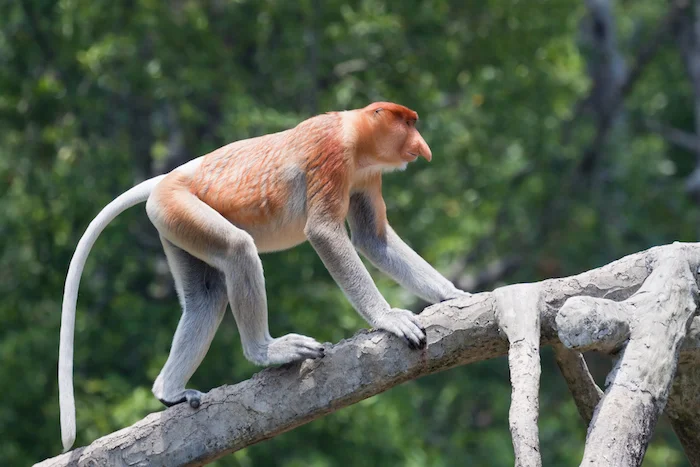This kind of monkey has a big nose.
They live in jungle on just one island.
That island is Borneo.
They live in groups and eat leaves.
They stay in the treetops most of the time.
They live near rivers and can swim.
What is a proboscis monkey?
These monkeys are found only on one island in the world. Proboscis monkeys live only on the Southeast Asian island of Borneo. Borneo is the third largest island in the world, and is divided among three countries: Brunei, Malaysia and Indonesia. About three quarters of the island is Indonesian.
Proboscis (say pruh-boss-kiss ) means 'nose'. These monkeys get their name because of their long noses.
Habitat and Distribution (where they are found)
Borneo's Kinabalu rainforest ©Getty Images
Borneo's rainforest is one of the oldest in the world.
The proboscis monkeys live in trees in mangroves and in other rainforest trees near rivers. Mangrove forests grow in coastal areas where salt water and fresh water mingle, and tree roots grow upwards to absorb nutrients from silt, water and even air.
©Getty Images
Appearance and Behaviours
Both males and females have long noses but the males' noses are much more prominent.
Scientists believe the nose acts like an echo chamber that helps make the monkey's honking noise louder and travel further. The sound is to warn other proboscis monkeys of danger, which mostly may come from clouded leopards, crocodiles or humans who hunt them for meat. The loud sound may also work as a way of attracting the attention of females and warning away other males that might be interested in the same females.
Female and young ©Getty Images
Both males and females also have pot bellies. This is because the family of monkeys to which proboscis monkeys belong, the colobine monkeys, have a special digestive system consisting of four stomachs to deal with digesting leaves, many of which are poisonous. For this reason, the monkeys cannot eat more of one kind of leaves than another, but keep their choices balanced. A quarter of their body weight is their stomach contents.
Males can be 70 centimetres long, females 60 cm. Their tails are as long as their bodies. They are the largest of the Asian monkeys. Adult proboscis monkeys are a light brown that becomes reddish around the head and shoulders and greyish on the arms, legs and tail.
Aboreal: living in trees
The proboscis monkeys are arboreal (say ah-bor-ree-ul), which means they spend most of their lives in the trees. They are good at climbing and swinging through the tree tops, a way of travelling that is called brachiation (say brack-ee-ay-shn). They sometimes make huge leaps from one tree to another on the other side of a river.
A young monkey clings to its mother as she leaps from one tree to another. ©Getty
But proboscis monkeys also walk on the ground to find food. On the ground they move on all four legs. They can swim too. Of all species (kinds) of monkeys, proboscis monkeys swim most often, leaping from trees to splash into the water. To help them swim fast, they have slightly webbed feet and hands. When there are crocodiles present, proboscis monkeys are able to swim silently without splashing so they don't attract attention.
Proboscis monkeys live in groups called harems, that usually consist of a male and around seven females, and young. They are crepuscular, which means active in the early morning and just before nightfall. They rest during the day and at night they gather and sleep in the safety of thick branches that hang over water.
©Getty Images
Diet
About 95% of their diet is leaves, preferably young leaves rather than tougher older ones. They also eat fruit and seeds. However, they will only eat unripe fruit, because the sugars in ripe fruit can cause a bloating of their stomachs that could kill them.
Because they are able to eat mainly leaves, they are the only medium sized mammal that lives in the canopy of the forest, so there is no competition for food. This is called a niche.
A newborn proboscis monkey has black fur and deep blue face for about 3 months. ©Getty
Life Cycle
About six months after mating with a male, a female gives birth to one baby. A newborn proboscis monkey has a deep blue face and black fur. After 3-4 months the colour starts to change to the brown shades of their parents.
Females in the troop help look after each other's young, sometimes even feeding other babies. The young stay close to their mothers for about a year, or until she gives birth again. Proboscis monkeys live for about 20 years.
Young proboscis monkey ©Getty Images
Conservation Status and Threats
Proboscis monkeys are classified as Endangered. Threats are the clearing of mangroves and logging of forests, which has reduced their habitat drastically. They are also hunted, and their gatherings in large groups near rivers makes them easy targets.
Attempts to breed them in captivity have not met with success.








